We use cookies to ensure you get the best browsing experience. By continued use, you agree to our privacy policy and accept our use of such cookies. For further information, click FIND OUT MORE.
By JESSICA BARTOLOME and MARGARET CLAIRE LAYUG
December 29, 2021
...there was nothing but sea and sky.
The sea was ruled by the goddess Maguayan, while the sky was ruled by the god Kaptan. As they decided to unite, three sons and a daughter were born to them, who were responsible for the existence of the sun, moon, and stars.
The story goes several different ways, but a common thread tells of Kaptan and Maguayan traveling to an island to plant a seed, from which grew a bamboo tree. And from that bamboo tree stepped out the first man and woman, Sikalak and Sikabay.
This is a well-known creation myth in the Visayas, but it’s hardly the only creation story in the Philippines. Being an archipelago means that there are countless stories about creation in the country, differing across provinces, regions, and islands.
There’s the popular Malakas and Maganda story from Tagalogs of Luzon; the Mindanaon legend about the sun Andaw and the moon Bulan; and the Suludnon story about the primordial giant Laki and giantess Bayi.
Over time, these stories have been changed and erased and forgotten, but one thing is for certain — for as long as humanity existed, they have been searching for answers to questions we’ve all had: Where did we come from? How was the Earth made? Why are things the way they are?
These birthed stories and beliefs and tales as old as time, all of which serve to give the unexplainable an explanation and make the unknown, known.
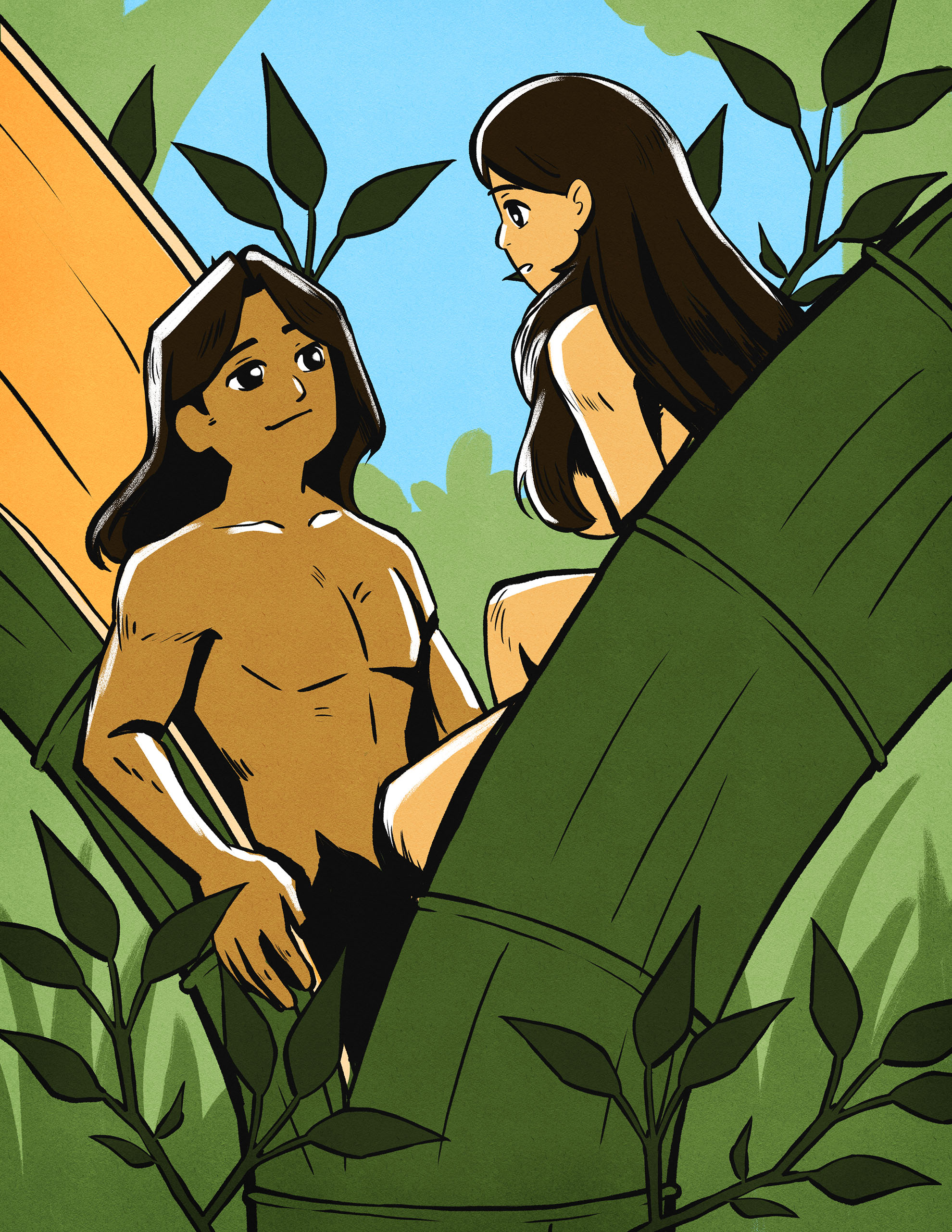
The legend of Malakas and Maganda has become part of popular culture over the decades, having appeared in literature, plays, and educational textbooks.
While Philippine lore is undoubtedly rich, what stands out is how it seems to be ahead of its time.
Take Malakas and Maganda, for example. The legend goes like this: once upon a time, a bamboo pole cracked open, and one half of it lay a man, the other half a woman. As the first humans in the world, they married and had numerous children.
Malakas and Maganda had long since become part of popular culture over the decades, having appeared in literature, plays, educational textbooks.
The myth about the man and woman from bamboo might have actually stemmed from a similar traditional Visayan story, as documented by Mabel Cook Cole in the 1916 book “Philippine Folk Tales.” Unlike the Biblical story of Adam and Eve where the woman is formed from the ribs of the man, created to be his companion, Philippine creation lores, whether it’s Malakas and Maganda or Sikalak and Sikabay, feature both man and woman born, fully-formed, at the same time.
While it is open to some interpretation, the message is clear: women did not come second. They are independent, powerful, to the point where they are portrayed as an important part of the creation process.
This idea mirrors the culture that had been present in the Philippines long before it was influenced by foreign powers. According to Dr. Marby Aubrey Villaceran, a professor from the University of the Philippines Center for Women’s and Gender Studies, Filipinos from the precolonial period had actively worshipped goddesses and placed women in positions of power in society.
“The Philippine precolonial culture was feminist even before the conception of the term,” she told GMA News Online. “Because the myths of early society included women in the process of creation, or they’re created as equal to men and portrayed as independent goddesses whose powers are not stolen from them. Or you have characters who are strong ordinary women.”
Among the many examples of notable women in Filipino lore is Alunsina, a goddess among the people of Panay. Said to be lazy and selfish, Alunsina got into a fight with her husband, the god Tungkung Langit, during which he lost his temper and divested her of her power, driving her away. Regretting his actions, Tungkung Langit tried to find her, to no avail.
Alunsina refused to return to Tungkung Langit even after he scattered her jewelry in the sky, where they became the sun, moon, and stars.
This story is an early portrayal of separation, echoing the right of Filipino women to freely leave their husbands back in the precolonial period.

Things changed for women in the Philippines after the arrival of Spanish colonists.
Villaceran said these legends “are actually reflections and mirrors of cultural situations and aspirations, so they actually give us insight in development and progress on human culture and human consciousness during that time.”
Aside from the respect given to them, precolonial women also enjoyed individual rights. According to the research of historian Teodoro Agoncillo, they could own and inherit property, engage in trade and industry, and succeed as chief should there be no male heir.
Women were also able to choose who to marry, and separate from their spouses should they wish to. They could keep their properties after separation, they had a say in how many children they wanted to have, and in some cultures, they had exclusive rights to name their children.
Not only that: their children could also carry their name.
This just goes to show that precolonial Philippine cultures placed women at an equal standing as men.
In terms of laws, adultery was not regarded as a crime, but rather a personal offense that the parties should settle. Society did not discriminate or punish. In terms of relationships, they were more lenient about premarital sex, and sexual relationships between unmarried men and women were allowed.
“When you think about it, it was more liberating for women, the conditions during that time,” Villaceran said. “Based on precolonial records.”
In fact, Villaceran said they didn’t even have a term for “virginity.” The Tagalog term closest to it is “dalaga,” but “dalaga” means a “young maiden of marriageable age.”
It was only when the Spaniards came that the term “birhen” was introduced.
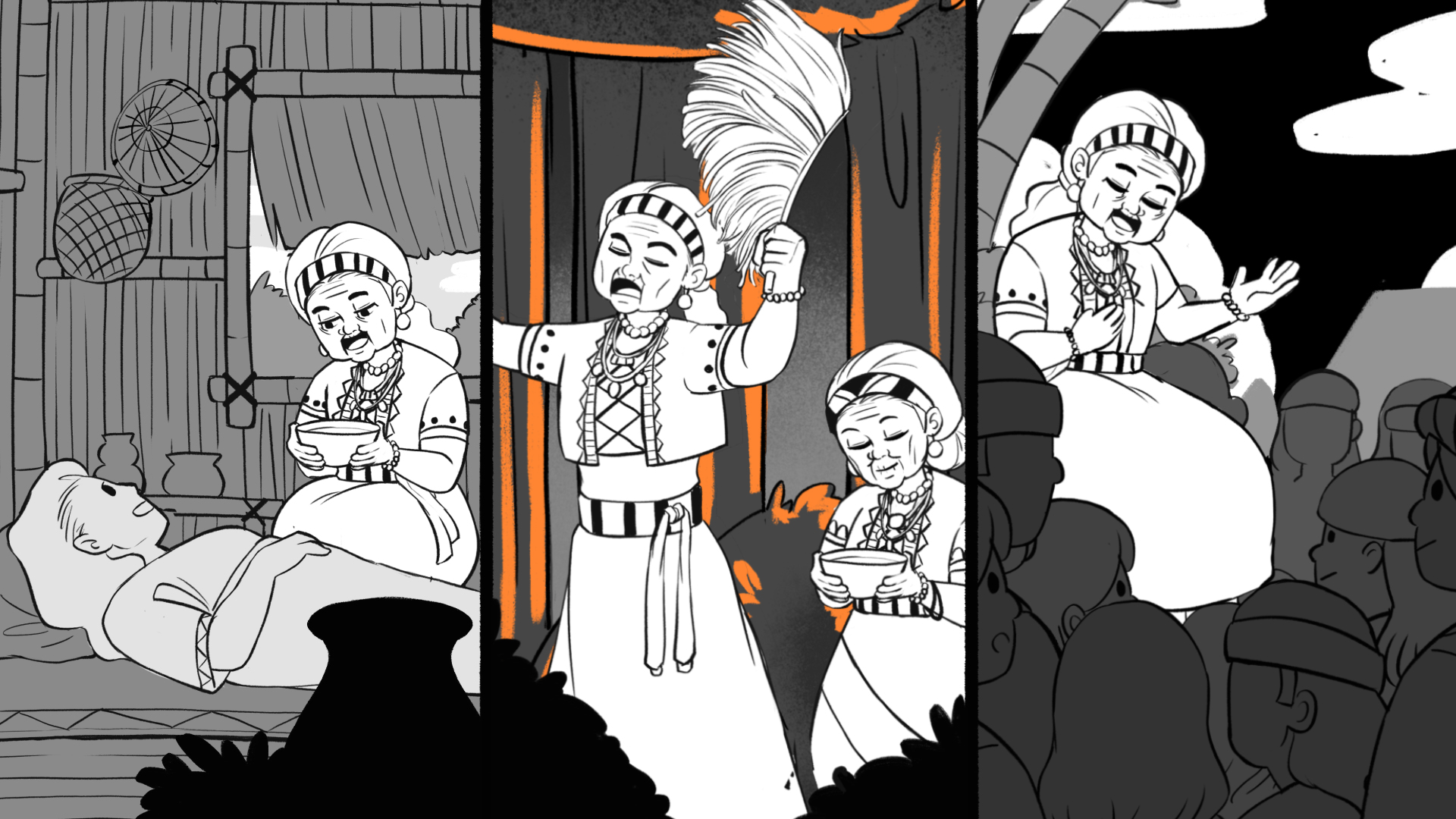
The babaylan had many roles in the community: priestess, healer, sage and seer.
...there existed in the Philippines the mystical people they call the babaylan.
They were said to be able to see the future. They were said to be able to communicate with the gods. They were said to have healing powers.
Undoubtedly, these people — predominantly women — were special. The vision of their role as a babaylan was said to have come to them in a dream.
The babaylan usually underwent or survived a life-threatening experience, a “rite of passage” that allowed her to gain knowledge and power befitting of their position.
And their era of power best encapsulates how women were perceived in the Philippines prior to the Spanish colonization in the 16th century.
Back then, power was divided among three specialists in a barangay: the datu, who oversees economics, military, and politics; the panday, who was the technical expert responsible for tools, jewelry, and weapons; and the babaylan.
In his research, anthropologist Dr. Zeus Salazar described the babaylan as “a specialist in the fields of culture, religion, medicine and all kinds of theoretical knowledge about the phenomenon of nature.”
They had many roles in the community: priestess, healer, sage and seer.
“Their position had prestige. They were treated with utmost respect as one of the three leaders in the community,” Villaceran said.
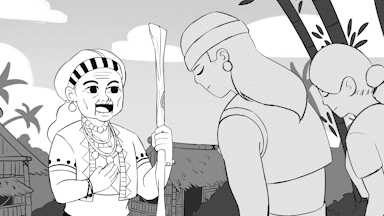
Even the strongest warriors in the community would pay tribute to the babaylan.
The role of the babaylan were not just limited to women.
Effeminate men who prove they could perform those functions may also take up the mantle.
In fact, by the 20th century, there were more of these men present in the ranks of the babaylan.
“Among early Filipinos, the man’s role is rooted in the physical world and the woman traverses the metaphysical and the physical world, so it’s no surprise that many of the healers are women,” anthropology professor Prof. Felipe Jocano, Jr. said.
“However, it’s important to remember that culture changes, and so do roles,” he added.
Villaceran pointed out that there is an idea of “fluidity” when it comes to gender in some Philippine cultures, which are reflected in the surviving lore. In certain stories, “men are not assumed to stay male for long, and women are not assumed to stay female forever,” she said.
“In some cultures, their characters can transition from male to female. It can be reflective of that. It is not assumed that they follow heterosexual binary imposed on us,” she added.
She is referring to deities whose genders remain unclear to this day, like Lakapati; legends of women who are said to have the ability to transition into male warriors, like the Binukot; and mythical beings who are both male and female, or neither.
“Another function of myths is to reinforce and strengthen social structures,” Villaceran said. “Basically the patterns of relations among people in social groups. It means it’s probably practiced as well in these particular cultures.
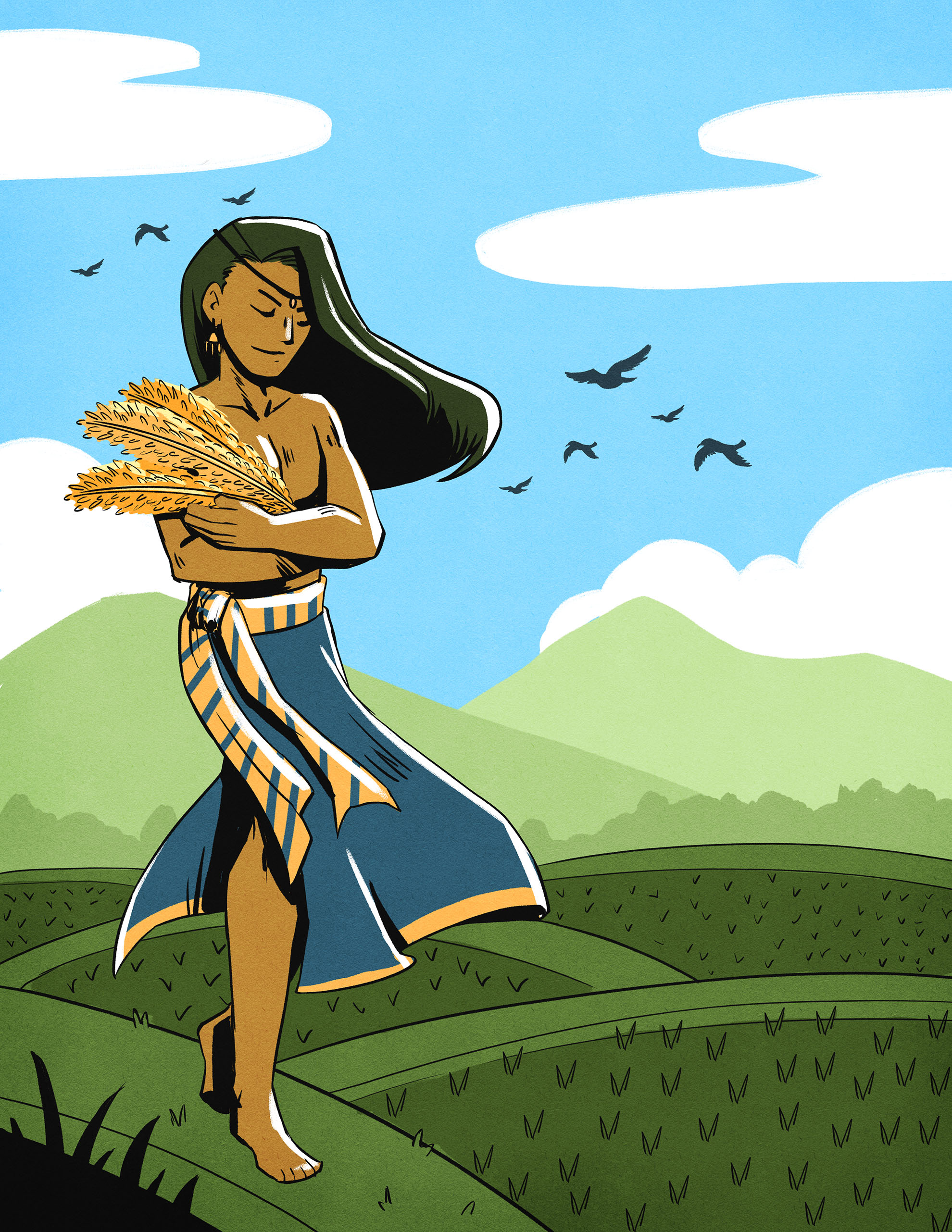
Lakapati was a great deity of fertility and agriculture to whom farmers offered sacrifices.
...there was the mystery of the Tagalog deity Lakapati.
The popular mythology blog The Aswang Project has noted how descriptions of Lakapati’s identity have varied in early historical entries such as that of Juan de Plasencia (1589), Boxer Codex (1590), Jocano’s “Outline of Philippine Mythology” (1969) and Vocabulario de la lengua tagala of Fr. Pedro de San Buenaventura (1613).
Today, many deem Lakapati as a transgender deity.
But whether Lakapati was a man, a woman, transgender, or a hermaphrodite, the deity was a great symbol of fertility and agriculture to whom farmers offered sacrifices.
“[Lakapati] didn’t just give them food and prosperity, [the deity was] also a giver of life, and that includes fertility and health,” said Dr. James Loreto C. Piscos, a professor at the Department of Social Sciences and Humanities at San Beda University-Manila.
Piscos doesn’t find it strange that Lakapati may have been a figure of both a man and woman, saying this possibility may reflect a philosophy among early Filipinos wherein sexes were equal and one with nature.
“Early Filipinos had this kind of culture already, where they are actually harmonizing everything… The concept of Western philosophy is always ‘man is the center of the universe [and] in control,’ using freedom, using free will and force, but when you look into the Eastern philosophy, including the Filipino concepts, we are part of the universe. We are part of nature, and that’s the impact of that. We are not in control but we are part of it,” he said.
“Lakapati is an embodiment [or] representation of that union, because both male and female are there,” he added.
“When I say gender doesn’t matter, it’s a good thing. We don’t give so much emphasis on gender, because you’re accepted no matter what you choose to be. It’s a choice, it’s a preference. No matter what you choose, you’re accepted.”
Both folklore and history paints a picture of an egalitarian society that existed in early Filipino culture.
In lore, there are powerful goddesses. In history books, there are the babaylan. In the mythical realm, there are beings who can shift genders.
And in a southern Philippine rainforest, there were the mentefuwaley.
The mentefuwaley were documented in the book “Wisdom from the Rainforest” by American anthropologist Stuart A. Schlegel. He encountered these people when he spent some time with the ethnic group Teduray.
There he met a person who was born biologically male, but whose duties, image, and clothes were that of a woman’s.
“In the precolonial Philippines, in areas that were not very colonized, they already had a concept of this mentefuwaley,” said Dr. Jay Jomar Quintos, who teaches Literature and Philippine Studies at the University of the Philippines Diliman.
“In the contemporary period, some would refer to them as transwoman or transgender, but if you look at those terms, they’re very Western,” he added. “But little do people know that we have this culture.”
This is supported by Schlegel’s translation of the Teduray term “mentefuwaley” — it means “one-who-became-a-woman.”
Quintos said that the mentefuwaley were accepted in the Teduray community, and that this was just one example of how inclusive the Philippines’ precolonial belief systems were.
“When I say gender doesn’t matter, it’s a good thing. We don’t give so much emphasis on gender, because you’re accepted no matter what you choose to be. It’s a choice, it’s a preference. No matter what you choose, you’re accepted,” he said.
And no matter how folklore and history are interpreted, it remains a fact that things started to change when the Spanish colonizers arrived on Philippine shores.
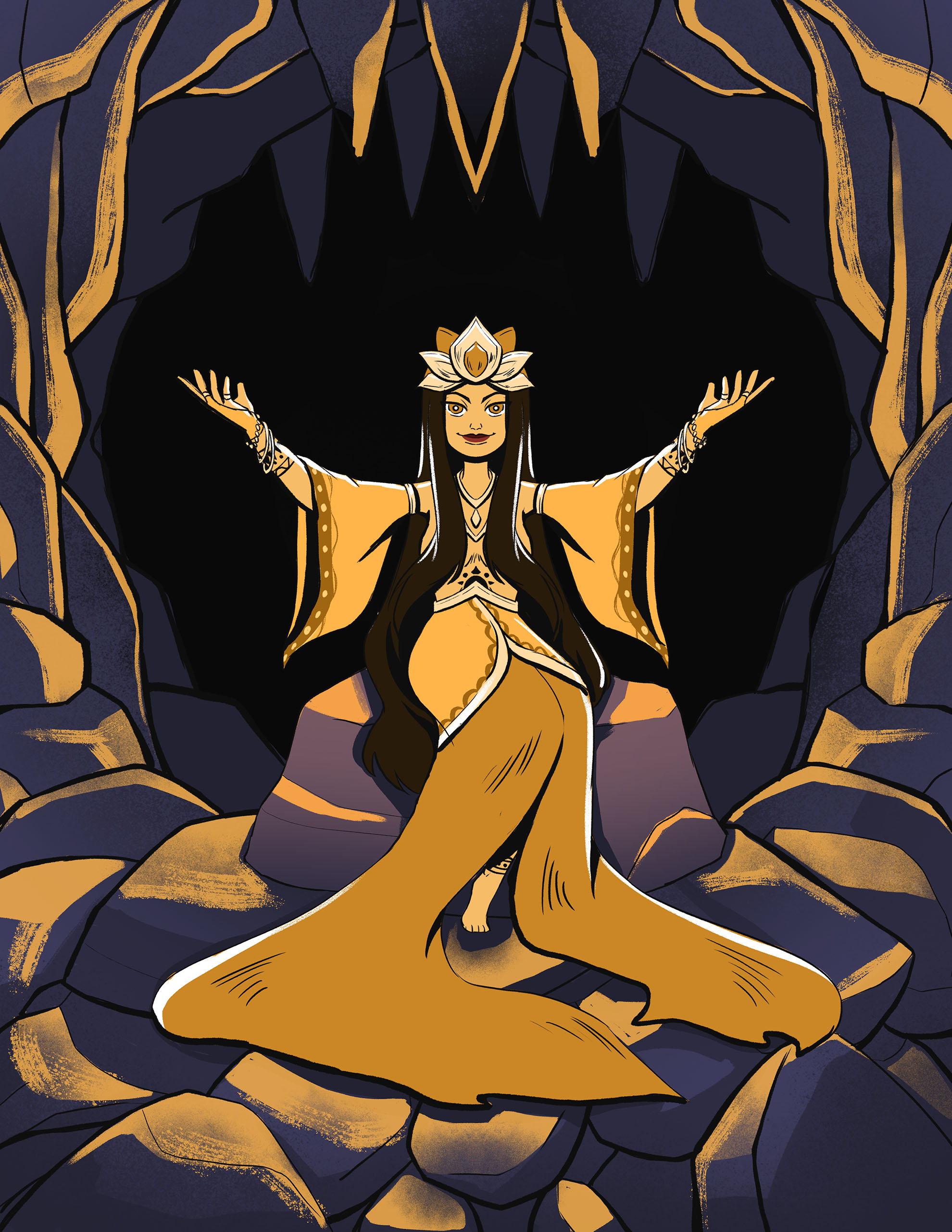
Nagmalitong Yawa Sinagmaling Diwata was a powerful baylan, a strong and independent woman in the epic “Labaw Donggon.”
...and a group of islands.
And then in 1521, the explorer Ferdinand Magellan arrived. The islands was soon named after the man who would be king, and then claimed as a colony of Spain.
Through fostered alliances, trade, and brute force, the Spaniards built an administration. With sermons and catechism, they introduced a new religion: Christianity.
In order to do the latter, they had to take down the babaylan.
“When the Spanish colonizers came, their missionaries perceived the babaylan as their great enemy. According to our history books, they burned all our records. They erased our history, as well as our culture, for them to impose their own,” Villaceran said.
“The erasure of culture is important because where would you base your identity if not culture? And who were the guardians of religion and culture? The babaylan,” she added.
The babaylan were among those who held their ground in the country’s earliest and violent resistances. As male chieftains and warriors who cooperated were given positions in the new colonial order, the babaylan lost their positions.
“Most of the babaylan opted to stay in the mountains. They were the ones saying to resist, preserve your beliefs,” Villaceran said.
Due to their resistance, Spanish friars conducted what Villaceran described as a “wide-spread disinformation campaign.”
The babaylan were then publicly labeled as “bruha,” or witches. They were called “anitera maldita,” or evil idol worshippers. They were called “satanic,” they were called “bad women.”
It was not just the babaylan who were demonized.
In the present day, a commonly heard derogatory Cebuano term is “yawa.”
“Pisting yawa,” people say, oftentimes as a curse.
But “yawa,” which can be translated as “devil” or “evil spirits,” could actually also refer to Nagmalitong Yawa Sinagmaling Diwata — a Visayan goddess.
“The Spaniards, in their attempt to gain control of the islands, demonized everything that wasn’t part of the Catholic setting,” said Jocano.
He explained that there are many versions of the story about Nagmalitong Yawa. In the epic “Hinilawod,” she was the beautiful wife of the sun god, Saragnayan. In the epic “Labaw Donggon,” she was a powerful baylan, a strong and independent woman.
This is not something the general public knows, with good reason. “The Spaniards labeled everything that had to do with the other religions [as something] from the devil,” Jocano said. “Even a title like Nagmalitong Yawa became instantly demonic, a work of the devil.”
And just like that, a being of power was turned into a being of evil.
How did a new religion and political order spread so effectively in only 300 years? Jocano said the new administration was built “partly from guns, partly from gold.”
“[The Spaniards did] trade, they brought things to allow the datu to profit, they signed a treaty. And then, [the datu] became part of the government. They agreed to be conquered because it was in their interest to do so,” Jocano said.
As for the religion, he said it was because there were many elements of the old and new belief systems that were similar.
“A lot overlaps with Catholicism and it wasn’t that difficult to accept it. Each saint had a function in the natural world,” he said. “How difficult was that then to simply switch over from an older belief system?”
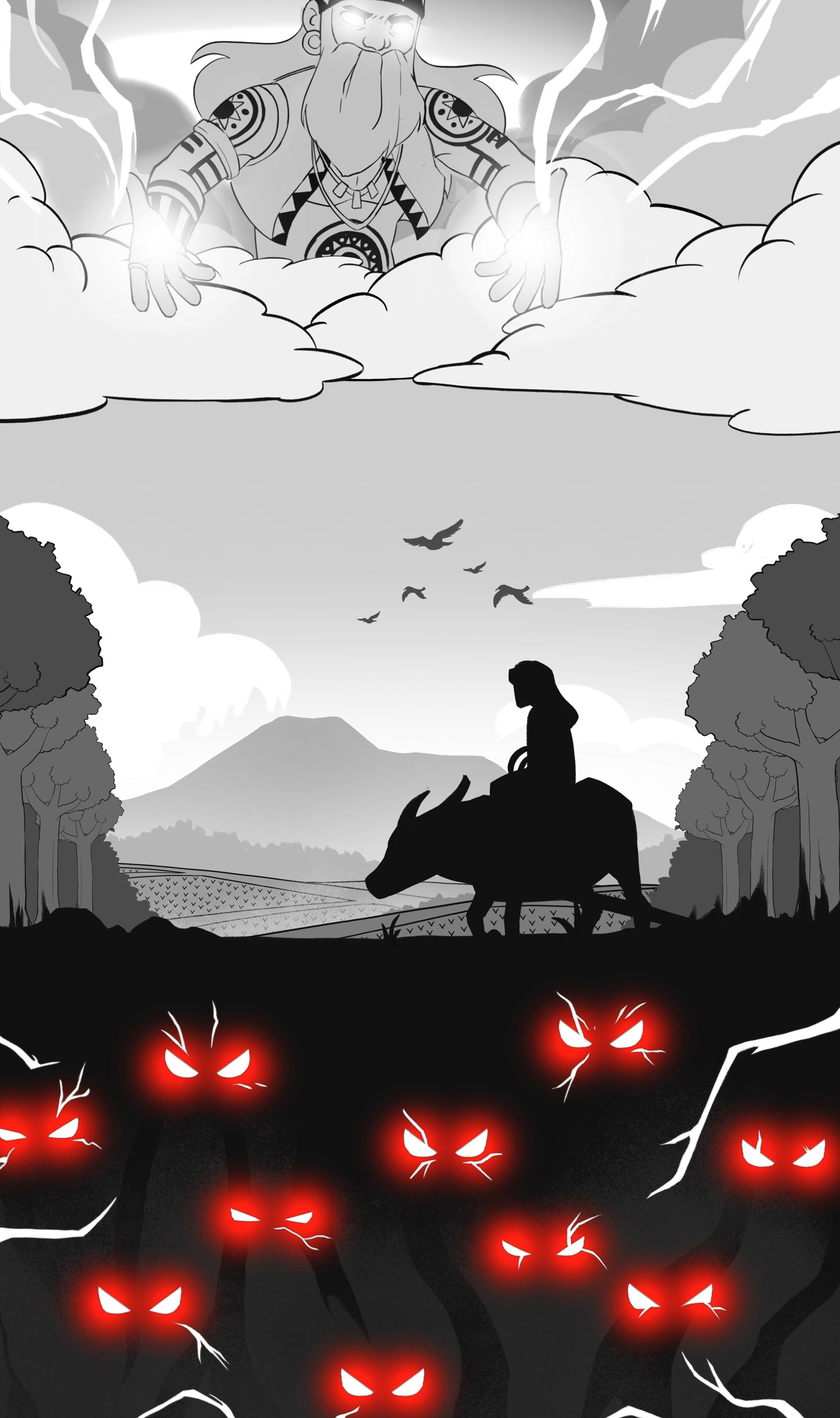
Filipino stories and lore have been drawing more interest across social media and popular culture.
... over a century, in fact, since the Spanish colonization ended, and 75 years since the Philippines was granted full independence by the United States, but Filipinos are still reeling from the consequences of the concepts introduced to their native culture.
Young women are afraid of stepping out alone after dark. Transgender women can’t enter the ladies’ restroom. Women and the LGBTQIA+ community continue to face microaggressions and discrimination. Even during Pride March, religious groups crash the annual protest to shame the individuals present, yelling at the top of their lungs through megaphones.
This is a far cry from how things were in ancient times. What was once easily accepted by Filipino ancestors are now deemed as crimes or sins. The idea of gender as a non-criteria for respect is all but gone.
“We still have misogyny. We have a President who’s being lauded for kissing someone in public, or groping someone who brought him a birthday cake, or what he said about ‘Si Mayor muna,’” Villaceran said, referring to President Rodrigo Duterte’s controversial comment about a rape victim. “And that’s OK with people.”
But not all hope is lost. There are still fragments of Philippine lore to this day — not just in the scholarly papers and communities that still practice their traditional beliefs, but in popular culture as well.
The world recently got a taste of Philippine horror mythology thanks to “Trese,” the Philippines’ first animated Netflix series based on graphic novels by Budjette Tan and Kajo Baldisimo.
Somewhere in the Mindanao campus of the University of the Philippines stands a statue of Mebuyan, a multi-breasted goddess of the underworld who, according to an ancient tale of the Bagobo, looks after dead children in the afterlife.
Meanwhile, the Babaylan and the Mentefuwaley inspire the name of local LGBTQIA+ student organizations who continuously fight for equality. Additionally, thousands of people like and share beautiful illustrations that depict Filipino gods and goddesses on social media, bringing back to life old beings from stories lost in time.
Villaceran also finds comfort upon noticing a “revival” of the babaylan in the past couple of decades.
In fact, the babaylan seem to have become the ideal for modern groups who are actively fighting for their rights. Case in point, the oldest LGBTQIA+ student organization in the country is called UP Babaylan.
“This reinforces our rejection of colonial beliefs which are actually oppressive to women and LGBT folk,” Villaceran said. “And reinstates the importance of women in Philippine culture.”
“What is passed down to us is the idea that women are weak, women are not born leaders. But actually if you look at the [old] culture, they’re strong, they were leaders in the community,” she added.
In fact, based on the noise about the topic online, younger generations are showing interest and willing to spread these stories, tokens of the Philippines’s past.
“Myths and stories are very important in our lives as humans in a social group as part of a culture. I guess... it reflects their current situation and aspirations. These stories are things we hold on to.”
It is one thing to keep a story alive, it is another thing to protect it.
A fervent debate brewed on social media recently concerning a viral story about Bulan, a Visayan moon deity, and Sidapa, a deity of the afterlife.
As netizens had been delighted to read about the story of two male gods falling in love, with fan art sprouting online, experts also expressed concern for supposedly spreading false and inaccurate information about Visayan myths.
Those knowledgeable about the topic stressed that nothing in the original documents stated the deities were in a relationship. They called the whole thing “fan fiction” and “fake lore.”
Of course, this didn’t sit well with netizens seeking inclusivity in their culture’s folklore, a point that the country’s scholars say is moot because Philippine folklore is already inclusive. It was only a matter of finding the right stories.
With the internet being highly accessible and swimming with information about “the history of this” and the “legend of that,” some scholars are concerned that clicking on the wrong thing can affect an entire ethno-linguistic community’s oral literature, which must be preserved to be passed down to future generations.
“On one hand, it’s good that the public is being informed about how rich, robust and vibrant our Philippine lore can be. But on the other hand, it can potentially be problematic especially if we borrow stories from cultures,” said Quintos, the literature and Philippine studies professor from UP.
“Creation stories, for example. We can’t just borrow a story of an ethnolinguistic group in the Philippines and interpret it as our own,” he added.
Quintos also said that creatives also play an important part in telling these stories to the world, because while there’s nothing wrong with creating works based on Philippine folklore, research is also necessary.
“It’s good because we can orient and educate even the younger generation about Philippine lores,” he said. “But you need to do your job, You need to do research. Especially if you are an artist — you wouldn’t just draw anything. You wouldn’t just shoot a film or write a screenplay without research. Writers need to do research, as well.”
Creator Budjette Tan talks about his graphic novel series Trese, which features numerous characters from Filipino folklore. The books have been adapted into a popular Netflix animated series.
Villaceran, from the UP Women’s and Gender Studies, has a different take.
“That’s how you keep stories alive,” she said. Due to the nature of oral literature, stories will change depending on who’s relaying them. And it “isn’t just done with Philippine mythology,” Villacaran continues. “There are lots even in Western mythology, Greek mythology, because now it’s more open to non-heteronormative relationships. Ideally, I would like to think, the world is more aware, if not more accepting.”
She said she understood why “the kids are reworking this.”
“Myths and stories are very important in our lives as humans in a social group as part of a culture,” she added. “I guess... it reflects their current situation and aspirations. These stories are things we hold on to.”
At the very least, this kind of debate is a sign that there is a demand for such stories due to the changing social landscape. After all, isn’t Alexandra Trese popular because her creators decided to give her a sword?
Perhaps all this is a step — rightly or wrongly — toward a certain direction: back to our egalitarian roots.
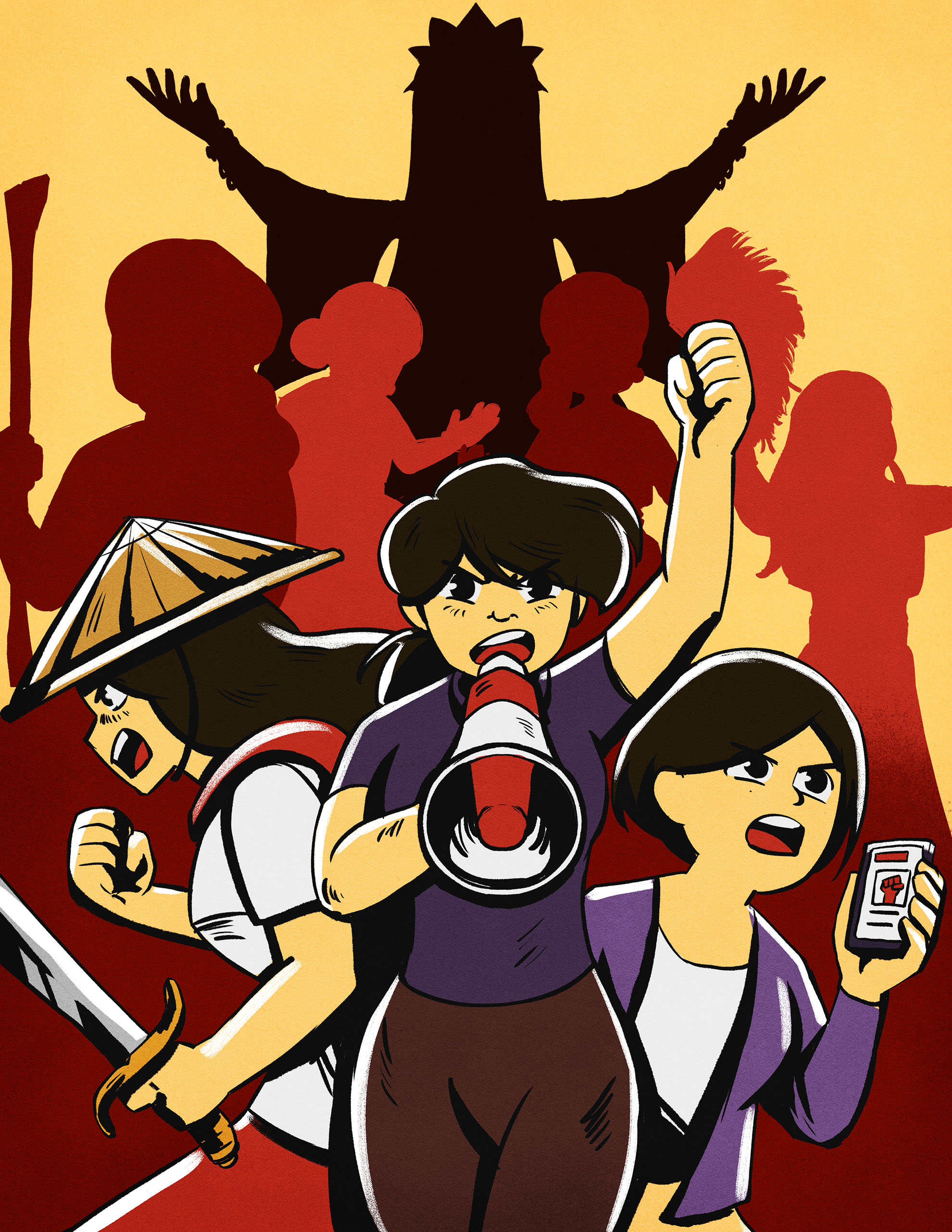
Folklore may be echoes from the past, but remain relevant to our future.
...what remains clear is that Philippine lore can be a rich source of inspiration in modern times. Ironically enough, it could be considered niche knowledge.
The general public would surely know bits and pieces of lower mythology, about creatures like aswang, tikbalang, and tiyanak, to name a few. But the majority probably wouldn’t know about the first Filipino vampire, Danag from Apayao, or the bird-like creature Alan from Abra.
Many Pinoys would know about the supreme being Bathala, but would scratch their heads upon hearing about Macaptan, the Visayan god of the earth, and Magyawan, the Visayan god of the sea.
This is not something that can easily be blamed on the colonizers for burying our old cultures, or on the youth for their disinterest. For one, Philippine folklore does not take up much room in most schools’ syllabus. Second, unless one is specifically on the hunt for them, books about the topic can be difficult to get a hold of.
Despite the renewed interest on social media, many Filipinos still tend to be disconnected from their native culture.
Robert John Pastera, a professor and representative of The Aswang Project, agrees that the stories are beginning to die over time. “We are becoming xenocentric; we prefer the culture and beliefs of other countries. Unfortunately, we don’t preserve our beliefs.”
There too is a decline in speakers of native languages. “These are not just languages. There are beliefs and cultures that come with these languages,” he said.
But why the need to preserve these myths?
Pastera described mythology as “entire belief systems that showcase how our ancestors interpret and perceive their surroundings.”
“They justify and sustain social order. We can learn from myths in a lot of ways, from respecting nature to respecting our elders,” he said.
“These are intangible cultural heritage, stories that will inspire the next generation because our culture is ingrained to it, and something that is ours,” he added.
Jocano, the anthropology professor, doesn’t believe that the battle to preserve said myths is so hopeless. There are lots of materials still out there, such as manuscripts in national archives. Aside from the documentary sources, there are also living sources. Jocano said that many communities still practice their old beliefs and traditions.
“The research can be done,” he said. “And then create access, and of course the translation. And the most important part is, apart from scholarly publication, transforming the work of translation into a popular work, something that can be taught [in history class].”
“If all of this can be turned into a work that can be digestible for students, enough to provoke them to ask questions and do more research, and then further cascaded downward into senior high, and elementary,” he added, stressing the importance of starting the education process early.
However, he said that these solutions are big, long-term projects that have to do with educating the next generation.
Short-term? It can be something as simple as engaging in social media.
Jocano believes this could help shed light on what the indigenous people, the owner of these belief systems, really think. “[We need to encourage] indigenous people to come out and also claim their narratives, and become the ones to tell their stories to us, instead of us telling another story for them,” he said.
“If we look at Philippine languages, they’re gender neutral... Even in Tagalog, even in Cebuano, even in Waray, even in Manobo… gender-neutral. The transformation happened when the Spaniards arrived in the Philippines.”
Some might say folklore is just a bunch of stories, or echoes from the past. But that is precisely why it’s necessary: there are aspects of the Philippines’ past that should be considered ideal in the present.
“Knowing about these stories, I always keep in mind that we come from a tradition of strong women, and a society that did not adhere to the colonial belief of gender binary,” said Villacera.
She said that it’s important for the youth to know that Filipino culture was once “less restricting, more open to freedoms and possibilities,” and adhered to ideas that “most colonial nations have only started realizing in the past decades.”
One example is the modern habit of the youth to state their pronouns so as not to be misgendered. You’d find it in their bios on Twitter and Instagram, and sometimes, they would go as far as to introduce themselves with their preferred pronouns in person.
This is a movement not just to show respect for one’s gender identity but also to create an inclusive environment. It also increases awareness that not all who were born female identify as female, and not all male
But in the Philippines, none of its many languages are gendered at all, so pronouns have never been an issue.
“If we look at Philippine languages, they’re gender neutral. ‘Ikaw,’ ‘siya,’ ‘sila,’ ‘tayo.’ Even in Tagalog, even in Cebuano, even in Waray, even in Manobo… gender-neutral,” said Quintos. “The transformation happened when the Spaniards arrived in the Philippines.”
Jocano shares the same sentiments regarding the importance of lore and what it stands for. “Even when you get older, you should also be teaching people that the mythology isn’t just simply stories that people don’t believe in anymore. They also represent the thinking of the world.”
He noted how Sigmund Freud developed his model for his psychoanalysis from Greek mythology in order to interpret the issues and problems that the middle and upper class in Vienna were facing.
“Imagine if we do a psychoanalytic theory for the Philippines but not from the Greek model, but from Philippine mythology,” Jocano said. “If for example, the key term in our creation story is that we were equal, then what would cause problems for people?”
Video by Yvan Limson / Artwork by KW Multimedia / Editing by Lou Albano
For more stories from the past, subscribe to Sounds and Stories from the Philippines, a podcast from Spotify and GMA News and Public Affairs.